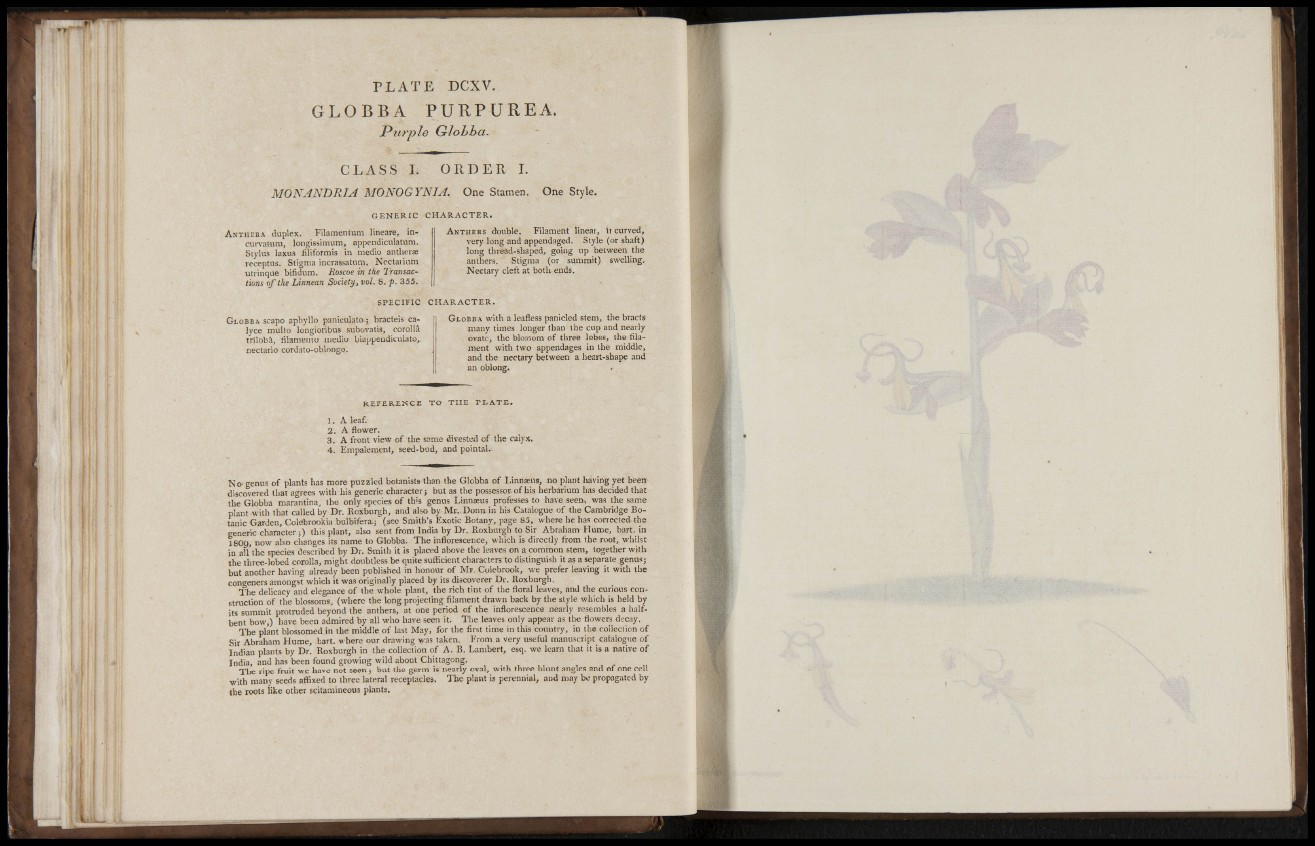
P L A T E DCXV.
GLOBBA PURPUREA.
Purple Glohba.
CLASS I. ORDER I.
MONANDRIA MONOGYNIA. One Stamen. One Style.
G E N E R I C CHARACTER.
A n t h e r a duplex. Filamenlum lineare, incurvatum,
Icaigissimura, appendiculatum.
Stylus laxus filiformis in medio antherae
receptus. Stigma incrassatum. Nectaiium
utrinque bifidiim. Roscoe in the Transactions
of the Linnean Society, vol. 8. p. 355.
A n t h e r s double. Filament lineai, ii curved,
very long and appendaged. Style (or shaft)
long thread-shaped, going up between tlie
anthers. Stigma (or summit) swelling.
Nectary cleft at both ends.
SPECIFIC CHARACTER.
G l o b e A scapo aphyllo paniculato; bracteis calyce
multo longioribus subovatis, corolla
triloba, filamento medio biappendiculato,
nectario cordato-oblongo.
G l o b e A with a leafless panicled stem, the bracts
many times longer than the cup and nearly
ovate, the blossom of three lobes, the filament
with two appendages in the middle,
and the nectary between a heart-shape and
an oblong.
REFERENCE TO THE PLATE.
1. A leaf.
2 . A flower.
3 . A front view of the same divested of the calyx.
4 . Empalement, seed-bud, and pointal.
No' genus of plants has more puzzled botanists than the Globba of Linnaeus, no plant having yet been
discovered that agrees with his generic character; but as the possessor, of his herbarium has decided that
the Globba marantina, the only species of th's genus Linnaeus professes to have seen, was the same
plant with that called by Dr. Roxburgh, and also by Mr . Dona in his Catalogue of the Cambridge Botanic
Garden, Colebrookia bulbifera.; (see Smith's Exotic Botany, page 85, where he has corrected-the
generic character;) this plant, also sent from India by Dr. Koxburgh to Sir Abraham Hume, bart. in
1800, now also changes its name to Globba. The inflorescence, which is directly from the root, whilst
in all'the species described by Dr. Smith it is placed above the leaves on a common stem, together with
the three-Iobed corolla, might doubtless be quite sufficient characters to distinguish it as a separate genus;
but another having already been published in honour of Mt, Colebrook, we prefer leaving it with the
congeners amongst which it was originally placed by its discoverer Dr. Roxburgh.
I ' h e delicacy and elegance of the whole plant, the rich tint of the floral leaves, and the curimis construction
of the blossoms, (where the long projecting filament drawn back by the style which is held by
its summit protruded beyond the anthers, at one period of the inflorescence nearly resembles a halfbent
bow,) have been admired by all who have seen it. The leaves only appear as tlie flowers decay.
The plant blossomed in the middle of last May, for the first time in this country, in the collection of
Sir Abraham Hume, bart. where our drawing was taken. From a very useful manuscript catalogue of
Indian plants by Dr. Roxburgh in the collection of A. B. Lambert, esq. we learn that it is a native of
India, and has been found growing wild about Chittagong.
The ripe fruit we have not seen; but the germ is nearly oval, with three blunt angles and of one cell
with many seeds aflaxed to three lateral receptacles. The plant is perennial, and may be propagated by
the roots like other scitamineous plants.